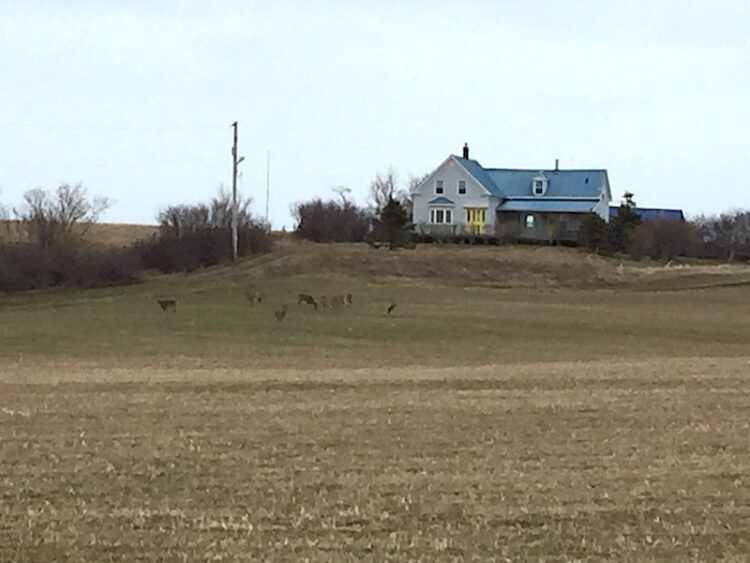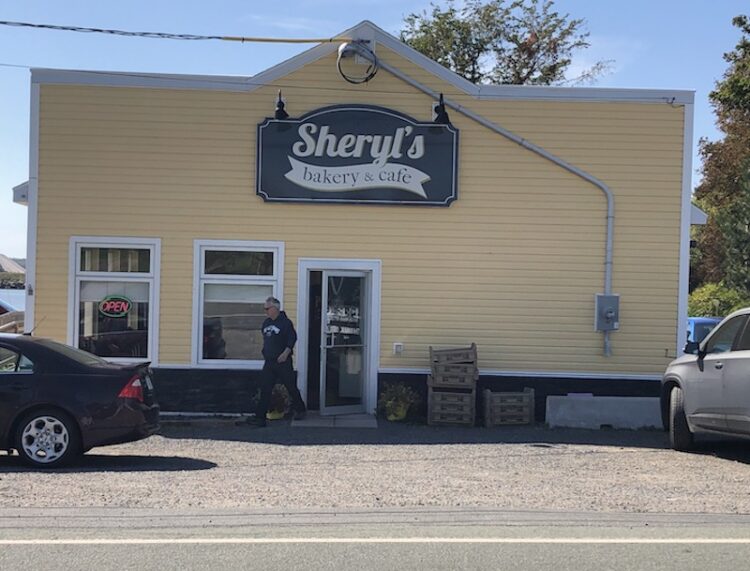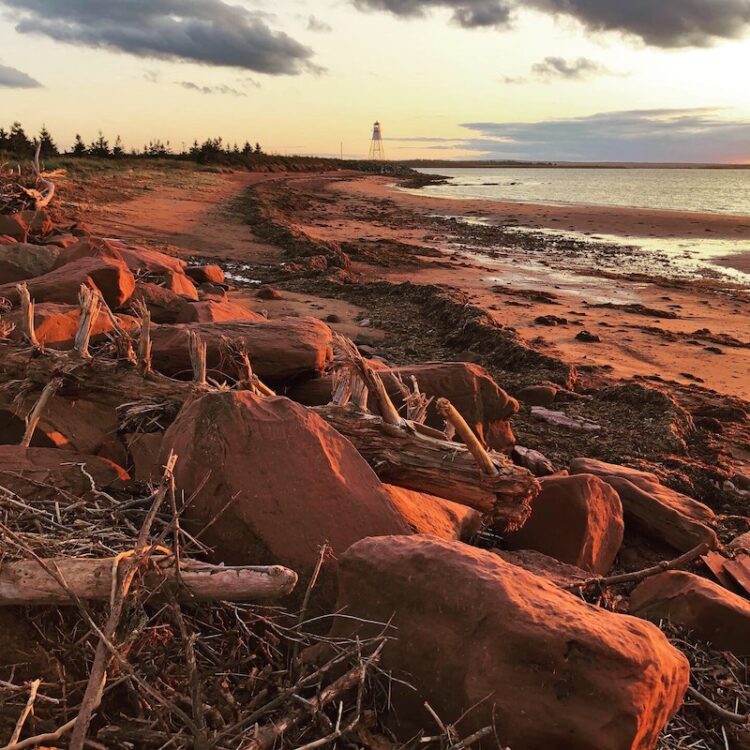Welcome to Cantastic Authorpalooza, featuring posts by great Canadian children’s writers! Today’s guest: Jean Mills. Take it away, Jean!
How the setting sparked the story: Larkin on the Shore
Warning, readers: I’m not a science writer. But like any scientist, I do incorporate research findings (of a sort) into my stories. Here’s one example that’s especially true of my most recent YA novel, Larkin on the Shore.
When stories come to me, they usually start with scenes, like in a movie. The scenes start to evolve, characters spring up and talk and interact, and the story arc forms.
Did you notice that I didn’t mention “setting” in that process?
It’s true. Of all the elements needed to create a story, setting is usually the one that creeps up on me last.
All that changed when I wrote Larkin on the Shore because Larkin’s story started with the setting: more specifically, with the shore.
My shore is found on the Northumberland Strait near Pugwash, Nova Scotia. Once it was a farm in my husband’s family, but now he and his cousins all have sections of the original land for homes that we use in the summer and more recently for me, during other parts of the year as well. It’s my other home, and it’s magic.
Into the setting, this scene, comes Larkin. Some bad things have happened to her and she’s reeling and needs help. Her “shore” is sometimes internal – she’s on the edge of something that could drown her and she’s also on the edge of making choices that will keep her afloat. But it’s a real shore, too. She finds it, sometimes unfamiliar and scary, and sometimes soothing, here at her grandmother’s house in the little Nova Scotia community of Tuttle Harbour (aka Pugwash).
Writing this novel became a personal exercise in lifting real places that I know well and weaving them as important features into the fabric of the story. So here we go, my “research”: a tour of the real-life setting in Larkin on the Shore. (And I’ll try not to give too much away as I guide you through.)
The shore
I need to capture this moment, store it somewhere so that I can pull it out when I need it – the water and sky, the muted far-off evening sounds and the silence right here around me…
The shore for me is a thinking place, and it becomes a thinking place for Larkin too, the bad thoughts and the good ones. Being out on our little stretch of the Northumberland Strait at sunset, at low tide, when the wind drops – what is it about water that makes us think deep thoughts?

The Tuttle Harbour Café and Reading Room
A café. A small-town Starbucks wannabe. Granne’s big retirement project.
Around the walls, shelves for books. Used books. And a corner that can be turned into a performance nook for cool singer-songwriters or fiddlers or aspiring poets and writers to read on special literary open mic evenings. An arts hub, Granne calls it.
There is a café in Pugwash – The Chestnut Café (seen here). Pleasant and efficient. But before this, it had different owners and a different feel. This earlier café, called The Chatterbox, was the model for Granne’s big retirement project. It was a café where you could sit and read or work, with used books on the shelves for borrowing, an arts hub for occasional Friday-night concerts. (The Chatterbox was also the place we went to get Wi-fi, but I didn’t include that part…!)

The library
They talk about books and Granne asks me what I’m reading (some mystery series that everyone at school is into) and she takes me to the library in the village, housed in the old train station.
The Pugwash Library is indeed housed in the old train station. It’s a tiny little place with the most welcoming librarians (I see you, Mary!) and it’s a regular stop during my stay in town every year.

Becca’s house
“Great,” she says and swings up the lane towards her house, a classic white farmhouse with gables in the black roof, a wide verandah overlooking the front field, over the road to another field, and the channel beyond. A bright red front door.
The description of the house is mostly made up by me, but there actually is a gorgeous old farmhouse up on a hill at the end of a long lane on our road. When we have campfires at our cousins’ farmhouse (a pasture lies between the houses), we can watch the moon rise right over the house. It’s classic, and I wanted Becca to live there because a local writer friend of mine actually did live there, with her aging parents, for a time. A bit of real life incorporated into the story (and this photo, taken in the spring, includes a herd of hungry deer, too. Bonus!)

Rug hooking
Colours everywhere. On the stretched burlap canvas. All around me on the walls as I look around slowly. Hangings of all sizes, some actual images of people or trees or buildings and some just a textured mash-up of water colours, or sky, or flowers. People dancing, an owl staring out, a horse and wagon, a giant sunflower.
“This is where I work,” Becca says. “What do you think?”
I’ve been a knitter for a long time, but I only took up rug hooking a few years ago after discovering a beautiful rug on display in Thinker’s Lodge, the Pugwash museum in the former home of industrialist and activist Cyrus Eaton. The rug was by local artist Deanne Fitzpatrick and I soon after visited her studio in Amherst, Nova Scotia.
I was –yes, sorry – hooked.
Whether knitting, crocheting or hooking, when I work with wool, yarn, hook or needles, I find not only a creative outlet, but also a soothing place of escape. Larkin needs that, something Becca recognizes, and so I used Deanne and her wonderful studio as a starting place for Becca and her art.

Brenda’s Bakery with its “magic” cookies
So I shrug, say, “Let’s get the stuff,” and wave the twenty in the air. “Maybe a coffee and a giant ginger-molasses cookie will fix everything.”
He actually laughs at that. “Yeah, Brenda’s cookies are like magic.”
It’s actually Sheryl’s Bakery. And yes, the cookies (and, I hasten to add, the cinnamon rolls) are magic.

Back to the shore, where it started and where it ends
The tide has just turned and the first sandbars are emerging as I walk down the beach towards the point. The waves sound different as they leave the bars, hiss a little. It’s a night sound, a sound I’ve come to recognize now after a month here on the shore.
The setting was such a crucial part of Larkin’s story – hey, it’s a big part of my life too.

Jean Mills is a professional writer, editor and YA author living in Guelph, Ontario. Her novel Skating Over Thin Ice (Red Deer Press, 2018) was nominated for the 2019 Red Maple Fiction Award and named to the USBBY 2019 Outstanding International Books List. Her latest YA novel is Larkin on the Shore, published this month by Red Deer Press.
Can’t wait to read the book! I loved the photos and the trip behind the scenes.
I’m about half way through Larkin on the Shore and I love it. Jean has woven these beautiful locations around Pugwash ( yes, I have seen them all) into her storyline in such a natural and creative way.